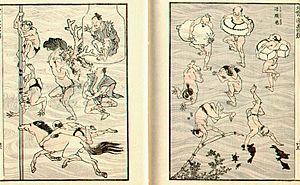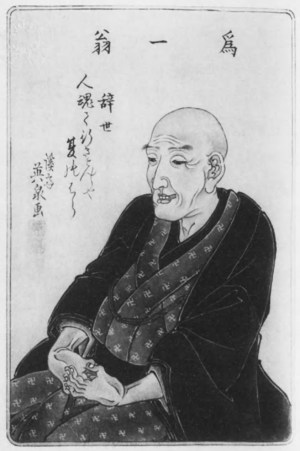Hokusai facts for kids
Quick facts for kids
Hokusai
|
|
|---|---|
| 北斎 | |
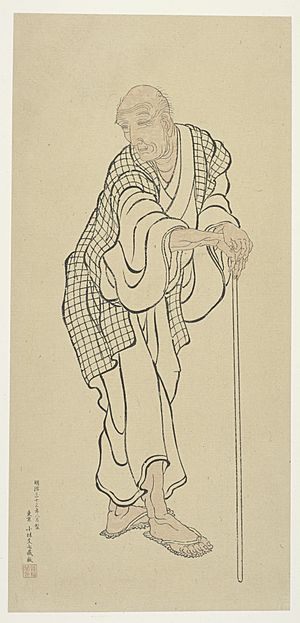
Self-portrait at the age of eighty-three
|
|
| Born |
Tokitarō
時太郎 supposedly 31 October 1760 |
| Died | 10 May 1849 (aged 88) Edo, Japan
|
| Known for | Ukiyo-e painting, manga and woodblock printing |
|
Notable work
|
The Great Wave off Kanagawa Fine Wind, Clear Morning |
Katsushika Hokusai (born around October 31, 1760 – died May 10, 1849), known simply as Hokusai, was a famous Japanese artist. He lived during the Edo period in Japan. Hokusai was a painter and a printmaker, especially known for his amazing woodblock prints.
His most famous work is a series called Thirty-Six Views of Mount Fuji. This series includes two very well-known prints: The Great Wave off Kanagawa and Fine Wind, Clear Morning. These artworks made him famous both in Japan and around the world.
Hokusai played a big part in changing ukiyo-e art. At first, ukiyo-e mostly showed portraits of actors. But Hokusai helped it grow to include landscapes, plants, and animals. His art also had a big impact on famous European painters like Vincent van Gogh and Claude Monet in the late 1800s. This influence was part of a trend called Japonisme, where European artists became very interested in Japanese art.
Hokusai created the Thirty-Six Views of Mount Fuji because many people in Japan were starting to travel more. He also had a special interest in Mount Fuji itself. He worked in many different art forms, including painting and illustrating books. Hokusai started drawing when he was very young and kept improving his skills until he died at 88. During his long career, he made over 30,000 paintings, sketches, and prints. He is considered one of the greatest artists in history because of his new ideas and amazing drawing skills.
Contents
Early Life and Training
Hokusai was born around October 31, 1760, in Edo, which is now Tokyo, Japan. His childhood name was Tokitarō. His father, Nakajima Ise, was a mirror-maker for the Shogun, who was the military ruler of Japan. Hokusai started painting when he was about six years old, possibly learning from his father.
Hokusai used many different names during his life, at least thirty! It was common for Japanese artists to change their names, but Hokusai changed his more than anyone else. These name changes often marked new periods in his art style.
When he was 12, Hokusai worked in a bookshop. These shops were like libraries where people could borrow books made from woodcut blocks. At 14, he became an apprentice to a woodcarver. Then, at 18, he joined the studio of Katsukawa Shunshō. Shunshō was a master of ukiyo-e, a style of woodblock prints and paintings. The Katsukawa school, led by Shunshō, mainly focused on pictures of popular kabuki actors.
After a year, Hokusai got his first new name, Shunrō, from his master. Under this name, he made his first prints in 1779, which were pictures of kabuki actors. During his time with Shunshō, Hokusai got married. He had two sons and three daughters. His youngest daughter, Ei, also became an artist and helped him with his work.
After Shunshō died in 1793, Hokusai started to explore other art styles. He even learned about European art from French and Dutch copper engravings. Because he was studying other styles, he was eventually asked to leave the Katsukawa school. Hokusai later said that this event actually helped him develop his unique artistic style. He also started to draw different subjects, moving away from just actors. He began to focus on landscapes and scenes of everyday life in Japan. This was a big change for ukiyo-e art and for Hokusai's career.
Middle Period and Famous Works

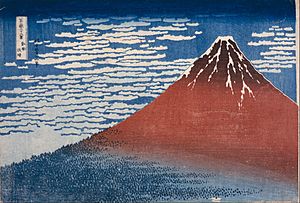
In the next part of his life, Hokusai joined the Tawaraya School and used the name "Tawaraya Sōri." He made many special prints for private events, called surimono. He also drew pictures for books of funny poems. In 1798, Hokusai became an independent artist, free from any school, and took the name Hokusai Tomisa.
By 1800, Hokusai was using ukiyo-e for more than just portraits. He also adopted the name he is most known by: Katsushika Hokusai. "Katsushika" was the area where he was born, and "Hokusai" means 'north studio', honoring the North Star. That year, he published two collections of landscapes. He also started teaching his own students, and over his lifetime, he taught about 50 pupils.
Hokusai became very famous over the next ten years, partly because of his art and partly because he was good at promoting himself. In 1804, during a festival in Edo, he painted a giant portrait of a Buddhist figure named Daruma. It was huge, about 200 square meters, and he used a broom and buckets of ink! Another story says he was invited to paint for the Shogun Tokugawa Ienari. Hokusai painted a blue curve on paper, then dipped a chicken's feet in red paint and let it walk across the paper. He told the Shogun it was a river with red maple leaves floating in it, and he won the competition.
Between 1804 and 1815, Hokusai worked with a popular writer named Takizawa Bakin on illustrated books. Their collaboration ended after a while, possibly because they had different ideas about how the illustrations should look. Hokusai was very particular about his work. He even wrote to his publishers and blockcutters to make sure his drawings were copied exactly as he intended.
In 1811, at age 51, Hokusai changed his name to Taito. During this time, he created the Hokusai Manga and various etehon, which were art manuals. These manuals, starting with Quick Lessons in Simplified Drawing in 1812, were a way for him to earn money and attract more students. The first volume of Manga (meaning "random drawings") came out in 1814 and was an instant hit. He eventually made twelve volumes, filled with thousands of drawings of objects, plants, animals, and people, often with a funny twist.
In 1817, he painted the enormous Great Daruma outside a temple in Nagoya. This painting was 18 by 10.8 meters! The event drew huge crowds and earned him the nickname "Daruma Master."
In 1820, Hokusai changed his name again to "Iitsu." This marked the start of the period when he became famous all over Japan. His most celebrated work, Thirty-six Views of Mount Fuji, was created in the early 1830s. This series included Great Wave off Kanagawa and Red Fuji. Hokusai used a Western style of perspective in The Great Wave to show depth, which was new for Japanese art. The series was so popular that ten more prints were added later. He also made other popular series like A Tour of the Waterfalls of the Provinces and Oceans of Wisdom. He also started drawing detailed pictures of flowers and birds, known as kachō-e.
Later Life and Legacy
Starting in 1834, Hokusai worked under the name "Gakyō Rōjin," which means "The Old Man Mad About Art." During this time, he created One Hundred Views of Mount Fuji, another important series of landscape pictures.
In 1839, a fire destroyed Hokusai's studio and many of his artworks. Around this time, younger artists like Andō Hiroshige were becoming more popular. When he was 83, Hokusai moved to Obuse at the invitation of a rich farmer. He stayed there for several years and created masterpieces like the Masculine Wave and the Feminine Wave. Between 1842 and 1843, Hokusai painted Chinese lions every morning as a way to ward off bad luck.
Hokusai kept working almost until the very end of his life. He painted The Dragon of Smoke Escaping from Mt Fuji and Tiger in the Snow in early 1849.
He always wanted to create better art. It's said that on his deathbed, he wished for "just another ten years... Just another five more years, then I could become a real painter." He died on May 10, 1849, and was buried in Tokyo. A short poem he wrote before he died said: "Though as a ghost, I shall lightly tread, the summer fields."
Influences on Art and Culture
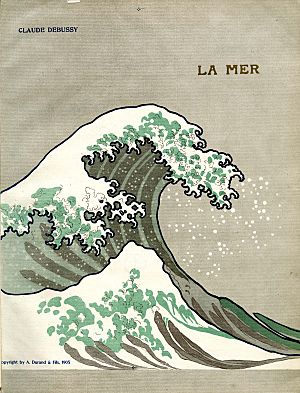
Hokusai achieved great things in many areas of art. He designed book illustrations, woodblock prints, sketches, and paintings for over 70 years. He was one of the first Japanese artists to experiment with Western ideas of perspective. Hokusai himself was influenced by older Japanese and Chinese painting styles.
His influence spread across the world, especially to Europe in the 1800s. This was part of a movement called Japonism, where European artists became very interested in collecting Japanese art, especially ukiyo-e prints. The French artist Félix Bracquemond discovered Hokusai's sketchbook Hokusai Manga around 1856, and this helped start the craze.
Hokusai's work influenced the Impressionism art movement, with themes from his art appearing in the works of Claude Monet and Pierre-Auguste Renoir. He also influenced Art Nouveau, a style popular in Germany. Many European artists collected his woodcuts, including Degas, Gauguin, Klimt, and van Gogh. Degas once said, "Hokusai is not just one artist among others... He is an island, a continent, a whole world in himself."
Even after his death, exhibitions of Hokusai's art continue to be popular. In 2005, a Hokusai exhibition in Tokyo had the most visitors of any exhibit that year. The British Museum also held a big exhibition of his later artworks in 2017, including The Great Wave.
Hokusai's art has even inspired stories and poems. The science fiction writer Roger Zelazny wrote a story called "24 Views of Mt. Fuji, by Hokusai" where the main character visits places painted by Hokusai.
Hokusai's print Store Selling Picture Books and Ukiyo-e shows how ukiyo-e prints were sold in local shops, making them available to ordinary people.
Hokusai's youngest daughter, Ei, who was also an artist, has her own manga and film called Miss Hokusai. A movie about Hokusai's life was released in Japan in 2021.
See also
 In Spanish: Katsushika Hokusai para niños
In Spanish: Katsushika Hokusai para niños



